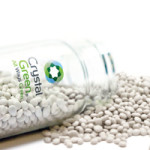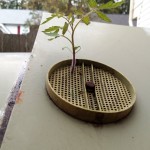Most people think what ends up at a wastewater treatment plant is exactly that – waste. Something that is worthless. Now, I admit it is smelly and gross. I’ve stood at the headworks of one of our larger plants, the place where sewage first enters to be treated and where big bar screens trap and filter out all of the large pieces of trash that somehow got down into the sewers. It’s not pretty. I may or may not have gagged. So when I say it’s smelly and gross, I speak from personal experience. How could anything useful come out of that? There is nothing left to be reused or recycled, right? Wrong.
When I talk about wastewater, AKA sewage, I’m not just talking about your toilet flushes. Sinks, showers, washing machines, dishwashers, restaurants, and other businesses all drain to the sanitary sewer system, which is a collection of pipes and pumps that send all that dirty water to our wastewater treatment plants to be cleaned. And all that dirty water adds up to about 150 million gallons a day. Still sounds like “waste,” I know, but it’s actually full of resources and resources can be reused as long as they can be recovered. That’s why wastewater treatment plants across the country are being renamed for what they actually are – resource recovery facilities. It’s not just about treating dirty water; it’s about REUSING and RECYCLING. Here are a few ways HRSD is recovering resources:
1. Nutrients – HRSD partners with Ostara Nutrient Recovery Technologies to recover phosphorous from sewage and turn it into an environmentally-friendly commercial fertilizer right here in Suffolk. It’s called Crystal Green® and its slow-release formula reduces fertilizer runoff as an added bonus. But it gets even better. Crystal Green® is made from struvite, a concrete-like material that builds up on the inside of sewage pipes and causes clogs. Not only are we reducing nutrients going into our waterways by removing them from the wastewater, but we’re creating something useful from something that is normally a big and costly pain-in–the-you-know-what.

HRSD’s Combined Heat & Power System uses 100% of the gas produced; previously, more than half the gas was wasted.
2. Energy – In Virginia Beach, HRSD’s Atlantic Treatment Plant Combined Heat and Power System generates renewable power and heat from gas produced during the plant’s treatment process. This system meets about half of the plant’s electricity demand and produces enough electricity to power 1,200 homes for a year. And P.S., cleaned water at this plant is sent into the Atlantic Ocean about 1.5 miles offshore, but a portion of it is routed through heat exchangers at the Dam Neck Naval Facility to provide energy-efficient building heating and cooling.

HRSD’s highly treated water passes through the Carbon-Based Advanced Water Treatment step at the SWIFT Pilot facility.
3. Water– The wastewater that flows to our plants every day is treated and then the cleaned water is sent into local waterways to be reused in the environment. But we decided we could do better than that. HRSD’s Sustainable Water Initiative for Tomorrow (SWIFT) will take highly treated water that would otherwise be discharged into local rivers and put it through additional rounds of advanced water treatment to meet drinking water quality standards. The SWIFT Water will then be added to the Potomac Aquifer, the primary source of groundwater throughout eastern Virginia. This will not only replenish our dwindling groundwater supply, but help the Bay by reducing the nutrients we currently discharge into local rivers, and help fight the impacts of sea level rise. Our SWIFT Research Center is currently under construction and you can check swiftva.com for updates and to learn more.
This might sound like resource recovery to the extreme, but ideas and technologies like these are being implemented all over the world as more communities seek forward-looking solutions. You can also turn your home into a resource recovery facility (and it’s way easier than what HRSD is doing!). Take the #BeRecycled pledge for America Recycles Day on November 15th and pledge to:
- Learn – Find out what materials are collected in your community.
- Act – Reduce the amount of waste you produce, recycle more, and buy materials made with recycled content.
- Share – Encourage others to take the #BeRecycled pledge.
This year I’m recovering resources by composting my kitchen scraps and yard waste. All of those leaves littering my backyard right now will be put to use fertilizing my garden beds in the spring. Check out the photo I took this week of my compost bin – it can’t wait to get started!

